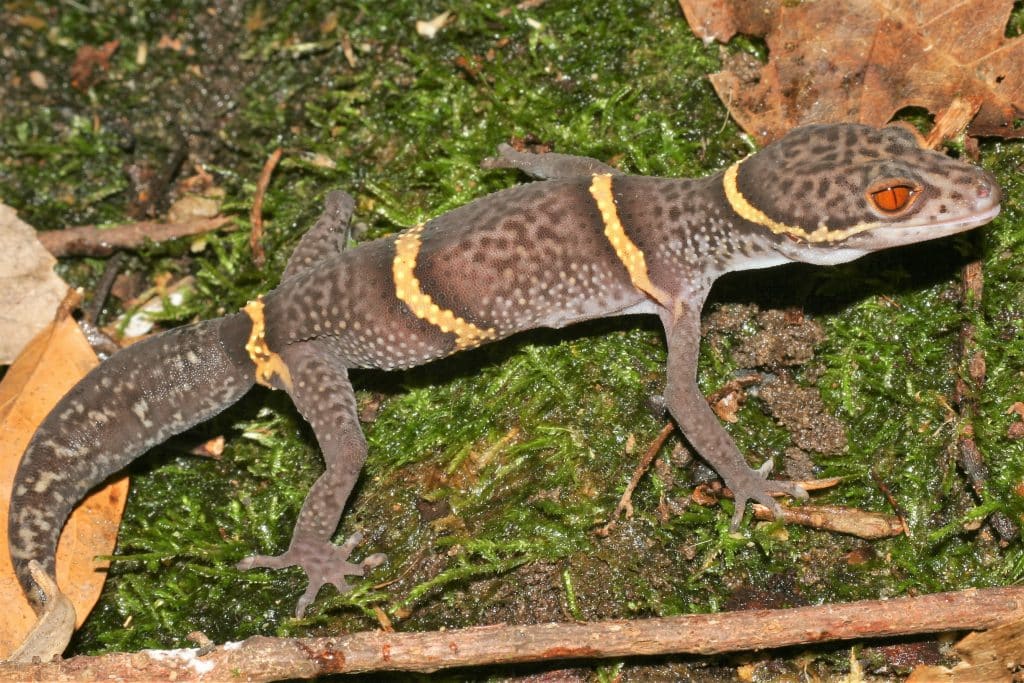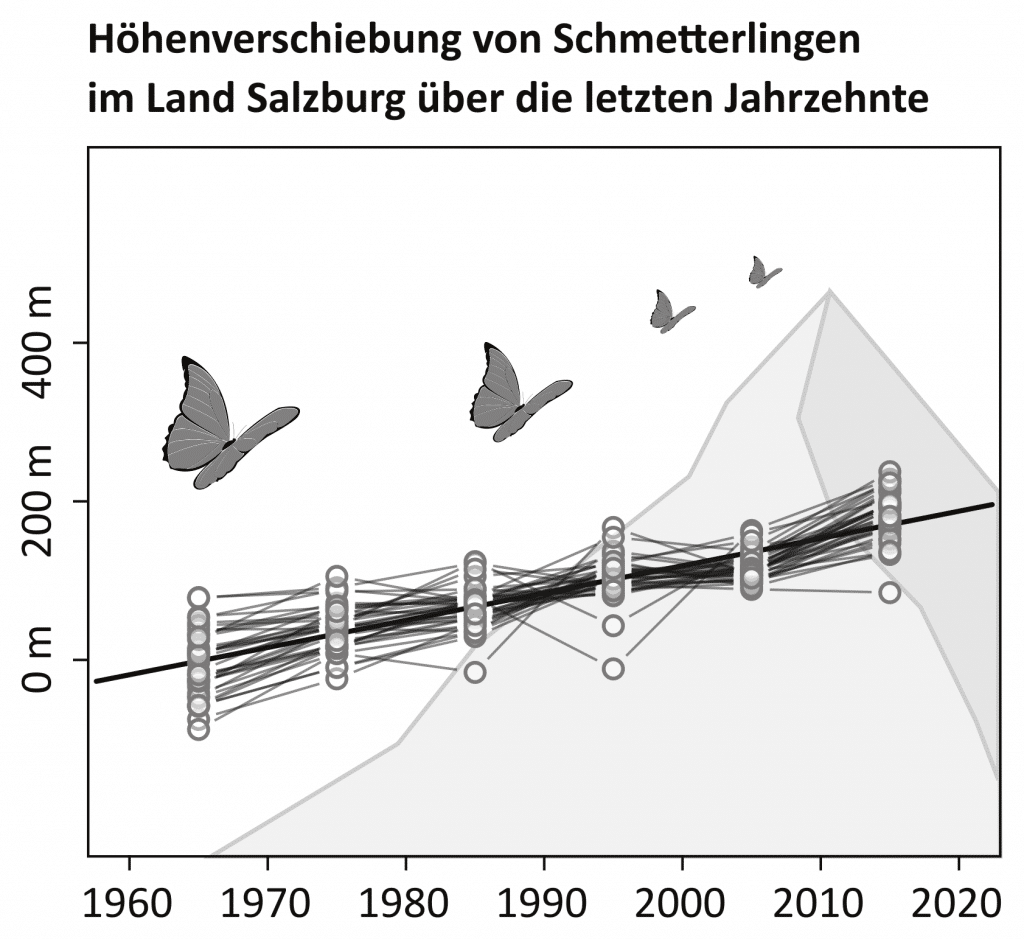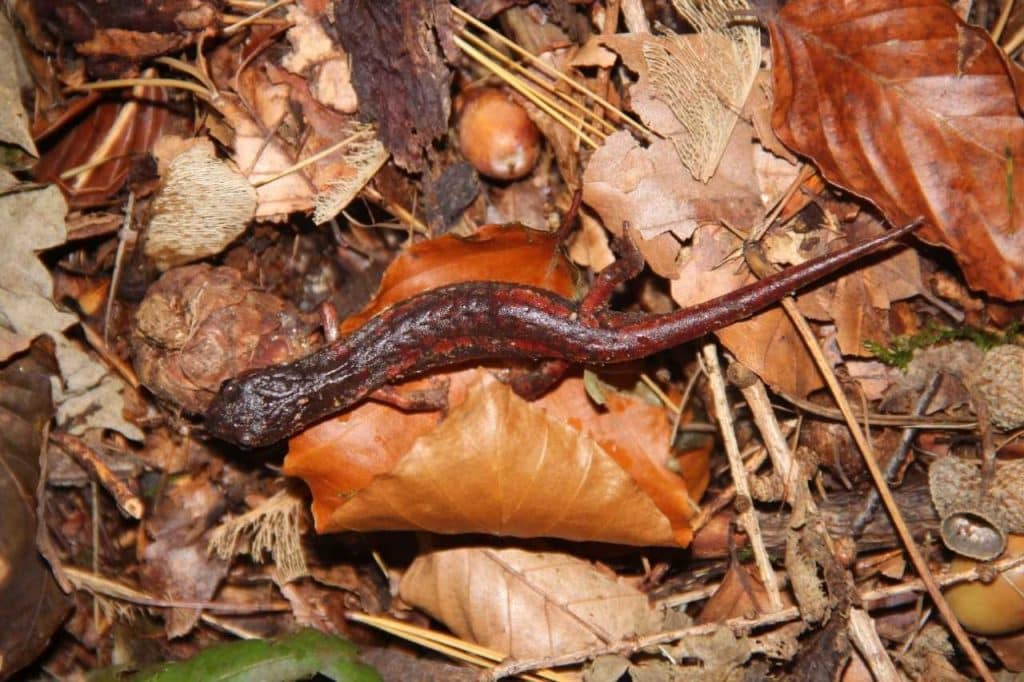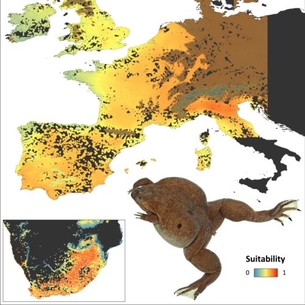German-Vietnamese team examines the effects of climate change on threatened reptile species
As a result of the change in the global climate, the optimal distribution of terrestrial organisms is shifting, which has particularly serious consequences for species with only a small distribution area. Lichtenfelder’s tiger gecko (Goniurosaurus lichtenfelderi) only occurs in a few forested areas in the Vietnamese-Chinese border area. The species is listed as Vulnerable according to the International Union for Conservation of Nature (IUCN).
The team around Prof. Dr. Truong Quang Nguyen from Vietnam’s IEBR, Hanoi, and Prof. Dr. Thomas Ziegler from Cologne Zoo and the modeling specialist Dr. Dennis Rödder from the Museum Koenig in Bonn, both Germany, examined the potential distribution under different climatic conditions. Tiger gecko researcher Hai Ngoc Ngo, who is writing his doctoral thesis in Cologne University / Cologne Zoo, Germany, and the Cologne master’s student Laurenz Gewiss essentially contributed to the study as well.
The models have just been published in the journal Frontiers of Biogeography: the analyses showed that the distribution could shift to the north in the near future and shrink considerably or that the species could disappear completely by 2070 due to a lack of suitable habitats.
Lichtenfelder’s tiger gecko was only recently included in the CITES appendices due to the research results and the input of the German-Vietnamese cooperation team. In order to counteract complete extinction, this threatened gecko is also cared for and successfully reproduced in the North Vietnamese Melinh Station for Biodiversity and in the Cologne Zoo, Germany, as part of conservation breeding.
The current study also shows which forests in the previously unprotected Chinese-Vietnamese border area are given the highest priority as a retreat for this species and that cross-border conservation projects and protected areas need to be set up there.
Ngo, H. N., H. Q. Nguyen, T. Q. Phan, T. Q. Nguyen, L. R. Gewiss, D. Rödder and T. Ziegler (2022): Modeling the environmental refugia of the endangered Lichtenfelder’s Tiger Gecko (Goniurosaurus lichtenfelderi) towards implementation of transboundary conservation. – Frontiers of Biogeography 2022, 14.1, e51167. doi:10.21425/F5FBG51167 (PDF)

Photo credit: Prof. Dr. T. Ziegler
Climate change drives mountain butterflies towards the summits
Climate change impacts biodiversity and is driving range shifts of species and populations across the globe. To understand the effects of climate warming on biota, long-term observations of the occurrence of species and detailed knowledge on their ecology and life-history is crucial. Mountain species particularly suffer under climate warming and often respond to environmental changes by altitudinal range shifts. We assessed long-term distribution trends of mountain butterflies across the eastern Alps and calculated species’ specific annual range shifts based on field observations and species distribution models, counterbalancing the potential drawbacks of both approaches. We also compiled details on the ecology, behaviour and life-history, and the climate niche of each species assessed. We found that the highest altitudinal maxima were observed recently in the majority of cases, while the lowest altitudes of observations were recorded before 1980. Mobile and generalist species with a broad ecological amplitude tended to move uphill more than specialist and sedentary species. As main drivers we identified climatic conditions and topographic variables, such as insolation and solar irradiation. This study provides important evidence for responses of high mountain taxa to rapid climate change. Our study underlines the advantage of combining historical surveys and museum collection data with cutting-edge analyses.
Rödder, D., T. Schmitt. P. Gros, W. Ulrich, and J. C. Habel. 2021. Climate change drives mountain butterflies towards the summits. Scientific Reports 11, 14382 (2021). https://doi.org/10.1038/s41598-021-93826-0

Italian Cave Salamanders in Germany?
Non-native species are among the main factors for the loss of biodiversity. For amphibians, especially some frogs and toads (i.e. Cane Toad or African Clawed Frog) have strong negative impact on ecosystems where these species do not belong. In contrast, only few cases are known where salamanders or newts were found in non-native ecosystems.
Cave Salamanders of the genus Speleomantes are endemic to France and Italy, with three species occurring across the Apennine mountain chain on the European mainland and five species on Sardinia. The common name Cave Salamanders is misleading as members of this genus are no obligate cave dwellers. However, Speleomantes are often found in caves but also in other habitats such as mines or crevices, where a moist and cold environment is provided over the whole year. These environmental conditions are necessary for efficient cutaneous respiration as Cave Salamanders are lungless. Since 2013, it is known that an introduced population of Cave Salamanders occur in the Weserbergland/Solling, Lower Saxony, Germany.
However, the identification of Speleomantes based on morphology is difficult and thus the identity of the German population was unknown and studies were lacking. Further, it was unclear if the German population is composed of just a few individuals that persist there for some years or if it is a reproducing, established population. For this reason, the Biologists Philipp Ginal (Zoological Research Museum Koenig in Bonn) and Carl-Henning Loske (Engineer Office Loske) visited the study area several times to collect and photograph the Cave Salamanders. On six capture events during the autumn of last year, the scientists found 70 different individuals of salamanders with only three individuals captured twice. Together with the colleagues Dennis Rödder (Zoological Research Museum Koenig in Bonn) and Thomas Hörren (University of Duisburg-Essen), capture-recapture models were calculated to estimate the population size.
As Cave Salamanders have a unique color pattern when they are adult, an individual identification is possible. Further, a recently published photographic database, comprising more than 1000 images of all eight Cave Salamander species, was used to give a tentative species identification of the German population. Our capture-recapture models estimate a population size between 170 and 485 individuals. Our results show that the German population is much larger than previously expected. However, the minimum estimate of 170 individuals is very unlikely and more realistically the population is much larger than this estimate. Additionally, we found that morphologically only some populations of the species S. italicus were identical to the German population. S. italicus is native to the northern and central Apennines.
Our tentative species identification was already proofed by genetic analyses of colleagues from the University Braunschweig. Further during field work, we could find juvenile Cave Salamanders as well as a pregnant female, which provides evidence for a reproducing population of Cave Salamanders in Germany. As Cave Salamanders are not native in Germany, future monitoring of the German population is required. However, yet the population seems to be restricted to a single rock scarp of c. 40 m length and negative impacts on the native fauna as well as concurrence with other amphibian species could not be observed yet. Sometimes the Cave Salamandes found together with the native Fire Salamanders or Alpine Newts in the same crevices.
Original publication:
Ginal, P., Loske, C. H., Hörren, T., & Rödder, D. (2021). Cave salamanders (Speleomantes spp.) in Germany: tentative species identification, estimation of population size and first insights into an introduced salamander. Herpetology Notes, 14, 815-822.

Caption: A specimen of the small population of cave salamanders in Weserbergland/Solling, Lower Saxony The animals have now been determined as Speleomantes italicus by genetic evidence and external appearance. How the species arrived at this location remains unknown.
Mögliche invasive Bedrohung durch den Afrikanischen Krallenfrosch wesentlich größer als gedacht – – mechanistische Modelle im Kampf gegen die unerwünschten Auswirkungen einzelner, verschleppter Arten
21.01.2021 Ein internationales Forscherteam um die beiden Herpetologen Philipp Ginal und Dennis Rödder vom Zoologischen Forschungsmuseum Koenig – Leibniz-Institut für Biodiversität der Tiere (ZFMK, Museum Koenig) nutzen einen neuen Ansatz zur Abschätzung des invasiven Potenzials einer Art. In einem ganz neuen Licht muss danach die Bewertung des Invasionsrisikos des Krallenfroschs gesehen werden. Die neue Berechnung weist in Europa ein Gebiet von fast zwei Millionen km2 möglichen Lebensraums für den Afrikanischen Krallenfrosch aus. Das ist etwa das Doppelte der Fläche, die man bisher angenommen hatte. Die Gefahr, dass die Art nicht ursprüngliche Heimatgebiete massiv negativ beeinflussen wird, ist also wesentlich größer als bisher gedacht. Hinzu kommt, dass es auch schon erste Anzeichen gibt, dass sich in Frankreich eingeschleppte Tiere bereits an das dortige Klima anzupassen beginnen und stark auf dem Vormarsch sind. Das mechanistische Model wurde jetzt im Journal of Experimental Zoology Part A: Ecological and Integrative Physiology beschrieben.
Der Afrikanische Krallenfrosch, Xenopus laevis, stammt ursprünglich aus dem südlichen Afrika. Die Art wurde in der Vergangenheit als Schwangerschaftstest und Modelorganismus für verschiedene Forschungsbereiche genutzt, was dafür sorgte, dass entkommene oder ausgesetzte Krallenfrösche invasive Populationen auf vier weiteren Kontinenten etablieren konnten. Mittlerweile gibt es sogar mehrere Populationen in Frankreich, Italien und Portugal. In den dortigen Ländern richtet die nicht-einheimische Art als Nahrungskonkurrent und Fressfeind großen Schaden an den dortigen Ökosystemen an. Zudem gilt der Krallenfrosch als Überträger des für Amphibien tödlichen Chytridpilzes (Batrachochytrium dendrobatidis), der neben der Habitatzerstörung einer der Hauptursachen des weltweiten Amphibiensterbens ist.
Eine Möglichkeit um das Risiko des invasiven Potenzials nicht-einheimischer Arten, die sich rasch ausbreiten können, abzuschätzen, ist das sogenannte Species Distribution Modelling, auch SDM genannt. Durch diese mathematischen Modelle kann vorhergesagt werden, welche geographischen Gebiete sich auf Grund der Umweltbedingungen für eine Art theoretisch eignen. Bisherige SDMs für den Afrikanischen Krallenfrosch haben jedoch nur einen Bruchteil der klimatischen Nische des Froschlurchs erfasst und somit nicht alle Gebiete, die klimatisch für die Art geeignet sind, vorhergesagt. Nun hat ein internationales Forscherteam um die beiden Herpetologen Philipp Ginal und Dennis Rödder vom Zoologischen Forschungsmuseum Koenig in Bonn im Rahmen des von BiodivERsA und durch die DFG geförderten INVAXEN-Projekts einen neuen Ansatz verwendet. „Mit unserem neuen Ansatz konnten wir durch Laborversuche die kritischen Minimal- und Maximal-, sowie Optimaltemperaturen ermittelt, unter denen der Frosch überleben kann“ erläutert Ginal die neue Vorgehensweise. Unter Berücksichtigung dieser physiologischen Eigenschaften wurde dann die potenziell mögliche Verbreitung in Europa vorhergesagt.
Mit Hilfe dieser sogenannten mechanistischen SDMs lässt sich die zukünftig prinzipiell mögliche Verbreitung einer Art genauer vorhersagen als mit den vorher verwendeten Methoden. „Durch den innovativen methodischen Ansatz war es sogar möglich die physiologischen Limits verschiedener Entwicklungsstadien, wie Kaulquappen und erwachsene Frösche, in das Model einzuspeisen, was vorher ebenfalls nicht möglich war“ legt Rödder dar. Die Ergebnisse der Studie von Ginal et al. (2020) zeigen, dass allein in Europa ein Gebiet von fast zwei Millionen km2 für den Afrikanischen Krallenfrosch geeignet ist. Die vorherigen Methodenansätze hatten dagegen lediglich maximal die Hälfte der Fläche vermuten lassen. Insbesondere Süd- und Westeuropa sind laut den Modellen der Forscher besonders gut für den Frosch geeignet. Aber auch vereinzelte Gebiete in Deutschland scheinen dem Klima des Froschs zu entsprechen.
Dies wirft ein ganz neues Licht auf die Bewertung des Invasionsrisikos des Krallenfroschs, berücksichtigt man, dass es auch schon die ersten Anzeichen gibt, dass sich die in Frankreich eingeschleppten Tiere bereits an das dortige Klima anzupassen beginnen und stark auf dem Vormarsch sind. In zukünftigen Studien planen die Forscher die Auswirkungen der lokalen Anpassung an das europäische Klima zu untersuchen, um weitere Erkenntnisse über den Afrikanischen Krallenfrosch in Europa zu sammeln und so den höchst invasiven Froschlurch von seinem Vormarsch abzuhalten.
Bildunterschrift: Rund zwei Millionen km2 sind als potenziell mögliches Habitat für den Afrikanischen Krallenfrosch in Europa vorhergesagt (Abb. oben). Zur Überprüfung der Korrektheit der mechanistischen Modelle haben die Forscher auch die Verbreitung der Art in ihrem natürlichen Lebensraum im südlichen Afrika korrekt vorhergesagt (in der Abbildung unten links).

Literatur: Ginal, P., Mokhatla, M., Kruger, N., Secondi, J., Herrel, A., Measey, J., & Rödder, D. (2020). Ecophysiological models for global invaders: Is Europe a big playground for the African clawed frog?. Journal of Experimental Zoology Part A: Ecological and Integrative Physiology.
Predicting terrestrial dispersal corridors of the invasive African clawed frog Xenopus laevis in Portugal
Invasive species such as the African Clawed Frog, Xenopus laevis, are a main threat to global biodiversity. Xenopus is native to Southern Africa but was introduced to four other continents. In Europe, the species could establish populations in France, Italy and Portugal. In our recently published study, we provide a novel approach, which was used to reconstruct the invasion of this highly invasive frog for Portugal. Using satellite data, including data on elevation, vegetation and land cover, we found that this almost fully aquatic frog most likely used a terrestrial corridor with three golf course ponds next to Laje River to reach a second river. Further, we give recommendations about possible future corridors, which will support the Portuguese eradication program for this frog.
Ginal, P., F. D. Moreira, R. Marques, R. Rebelo, and D. Rödder. 2021. Predicting terrestrial dispersal corridors of the invasive African clawed frog Xenopus laevis in Portugal. NeoBiota 64: 103–118.







